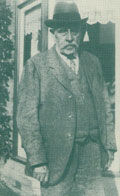
BEFORE THE BULLDOZER
A Nottingham allotment site destined for change
Trees
Trees are classified as either “softwoods” – the conifers – or “hardwoods” which are also sometimes called broad-leaved trees. Confused? So are we! For the sake of this exercise our classification of trees will be simply...
“Fruit Trees” or “Trees" !
Of course, being gardeners, the fruit-bearing trees are especially close to our hearts so we will begin with them.
Fruit Trees
The allotment gardens are full of fruit-bearing trees, and their blossom provides an abundant source of nectar and pollen for bees and other insects. There are no accurate records of most of the varieties on the site, but more recently gardeners have tried to identify the trees they have inherited, some from the beginning of gardening on the site in the 1930s. Some of the photo captions refer to parameters reported in the Arboricultural Survey carried out on behalf of the developers (e.g. Retention Category, Height): see Tree section below for Key to descriptions.
Click to enlarge/identify:

Martin's apricots, plot P25 [31/07/15]

Eileen's Bramley apple, a very prolific bearer

Mistletoe on Ray's apple 'Golden Delicious' [18/03/15]. Please visit the Wild Nottingham site for interesting background information -

Martin's apricots, plot P25 [31/07/15]
Nottinghamshire's famous Bramley Seedling apple
The first Bramley tree grew from one of a number of pips planted in 1809 by a young girl, Mary Ann Brailsford, in her family's cottage garden in Southwell, Nottinghamshire, England. In 1846 a local butcher, Matthew Bramley, bought the cottage and garden. While Matthew Bramley lived there a local nurseryman, Henry Merryweather, asked to take cuttings from the tree in order to start to sell the apple. In 1856 Bramley agreed, but insisted the apple should bear his name – hence ‘Bramley’s Seedling’.
Matthew Bramley
Henry Merryweather
The first recorded sale of the variety is in Henry Merryweather’s book of accounts on 31 October 1862. He sold “three Bramley apples for 2/- to Mr Geo Cooper of Upton Hall”. Upton Hall became the headquarters of the British Horological Society in 1972. H. Merryweather & Son Ltd still run a nursery in Southwell, NG25 0AH. The famous damson 'Merryweather' was developed there.
The fruits of the grafted apple were rated ‘highly commended’ by the Royal Horticultural Society’s Fruit Committee on 6 December 1876. In October 1887 Bramley’s Seedling received a First Class Certificate by the Committee of the Royal Jubilee Exhibition of Apples held in Manchester. The Nottingham Botanical Society awarded the Bramley a First Class Certificate in 1889, and at the Gardening and Forestry Exhibition in September 1893. That same year the Royal Horticultural Society’s Apple Show awarded the Bramley further First Class Certificates.
In 1900 disaster struck when the original Bramley tree blew down during violent storms; however, the tree somehow survived and is still bearing fruit more than 100 years later.
During the early 1900s the Bramley trees were extensively planted, with the fruit providing a useful source of food and vitamins during the First World War. The 1944 Fruit Census recorded Bramely’s Seedling Trees being one-third of the 6.25 million total of the trees in commercial plantations in England and Wales.
The Bramley growers themselves worked closely together during the 1980s to expand their market opportunities and, through the Bramley Campaign, which was set up in 1989, ran and are running successful consumer campaigns funded by voluntary subscription.
In 2003 The Bramley tree was one of fifty great British trees chosen by the Tree Council’s country-wide network of tree wardens, as a special way to mark the Golden Jubilee and to celebrate fifty great years – one for every year of the Queen’s reign.
The old nickname for the Bramley was “The King of Covent Garden” and is still used today in the New Covent Garden Market, where all specialist fruit wholesales can offer Bramleys to their customers for 12 months of the year.
The original Bramley apple tree continues to bear fruit to this day. Those few pips planted by a little girl in her garden in Nottinghamshire over 200 years ago are responsible for what is today a £50 million industry, with commercial growers across Kent, East Anglia and the West Midlands.
The cottage in Southwell where the first Bramley grew The original Bramley Seedling
Acknowledgements/links: www.bramleyapples.co.uk, www.bramleyapples.org.uk
Trees
Well, we have made a start...





Immature sycamore [Acer pseudoplatanus]: a 15th century introduction. Originally native to central, eastern and southern Europe

This sycamore adjacent Martins Pond regularly suffers the maple tar-spot fungus [Rhytismia acerinum]. Sycamores can live well over 400 years.

Wild cherry or blackthorn? Needs checking. 27/03/15

Immature sycamore [Acer pseudoplatanus]: a 15th century introduction. Originally native to central, eastern and southern Europe
Key to captions:
RC-x = Retention Category as defined in the Arboricultural Survey [see footnote below for details].
H = height
Tnn = Tree number in the Arboricultural Survey
Gnn = Group number in the Arboricutural Survey
Hnn = Hedge number in the Arboricultural Survey
Total items surveyed = 132, of which 23 are fruit trees
________________
Retention Categories :
Category A: Retention most desirable : 2 oaks with Tree Preservation Orders on eastern boundary
Category B: Retention desirable : 24
Category C: Could be retained : 103 (including hedges)
Category R: Tree for removal : 1
Most of the trees on the boundaries with existing housing are defined as Category B. The mature beech trees on Russell Drive are defined as Category A.